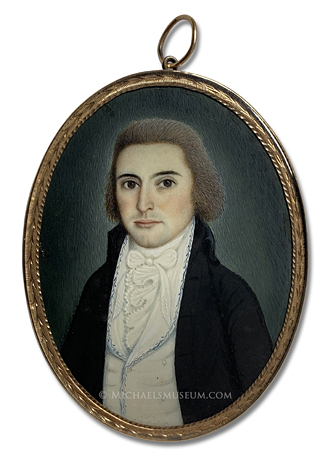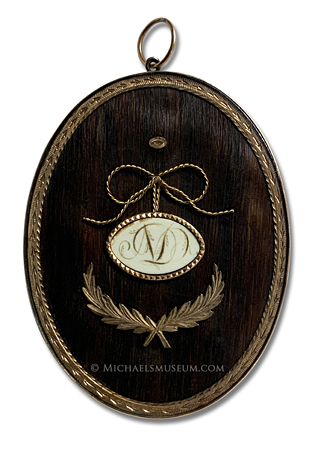American Artist: Isaac Sanford


Federalist Era Gentleman
with Connections to Freemasonry
American
circa 1795
by Isaac Sanford (1763-1842)
1 5/8 x 2 1/4 inches (sight)
watercolor on ivory; housed in a gold case with hairwork
and Masonic iconography to the reverse


Reverse Side of the Federalist
Era Gentleman's Portrait
Depicted is a Connecticut gentleman believed to have been a Freemason,
due to the Masonic iconography that appears on the reverse side of the
gold case.
The reverse contains a delicately arranged layer of the sitter's hair,
which is rich brown
in color. (His hair looks more gray in the painted
portrait because it was powdered, as was fashionably common at the
time.) Fixed atop the hairwork appears a cartouche bearing the gentleman's
initials: "MD". The cartouche is suspended by a bow made of gold thread.
Above the bow appears a tiny eye, made of gold. This eye is a classic
sign of Freemasonry, referring to the watchful eye of God. (It is the same
eye that appears on the reverse side of a one dollar bill, above the
pyramid -- most of our founding fathers were Freemasons, hence the
inclusion of such imagery on our currency.) The crossed laurel boughs
below the cartouche are also symbolic of Freemasonry. In ancient
Greek times, the symbol referred to victory. In the context of
Freemasonry, it typically refers to the bearer having achieved
a high level within the Masonic organization.
In addition to having painted the gentleman's portrait, it is believed that
Sanford also created the miniature's gold case, and the hairwork and
iconographic elements to the reverse. By his advertisements
throughout the 1790s, we know that Sanford was not just a painter,
but also a silver and goldsmith. He made gold cases for miniatures,
created hairwork art of various kinds, made seals, cyphers and
gold symbols, and created mourning jewelry.
|